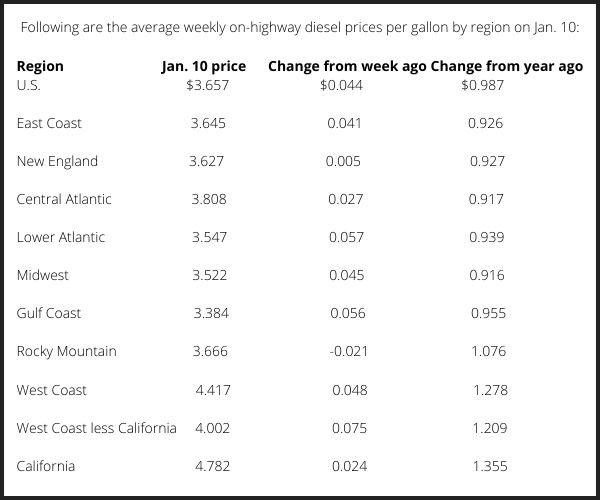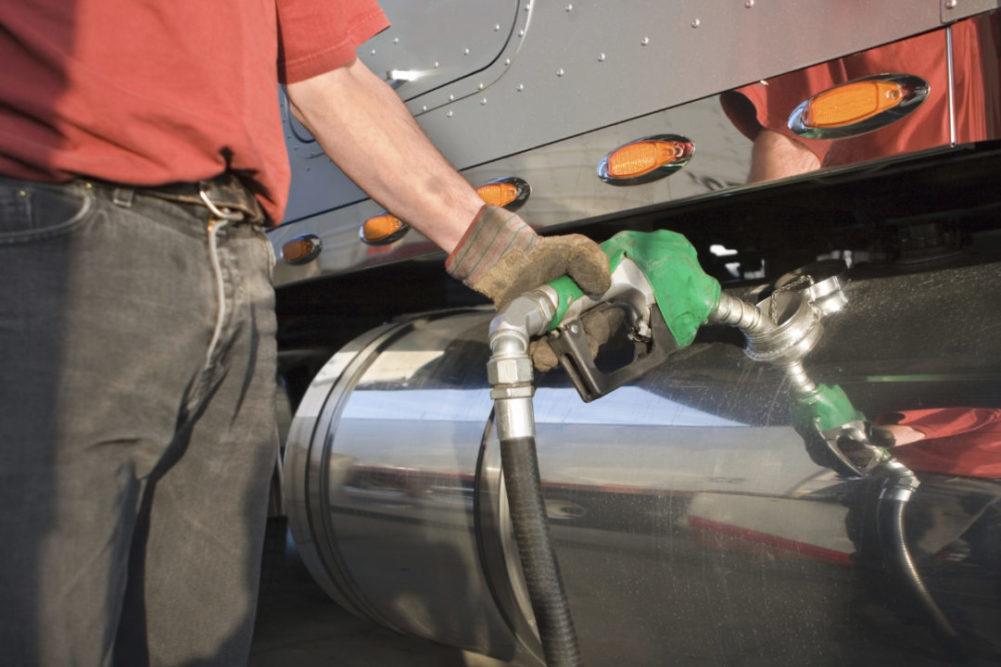KANSAS CITY, MISSOURI, US — Michigan and Nebraska implemented the widest changes in fuel tax surcharges among the dozen or so states in which such changes took effect Jan. 1, the US Department of Agriculture said in its weekly Grain Transportation report.
The first adjustment in Michigan is estimated to raise fuel rates by about 1¢ per gallon. Michigan’s fuel taxes are linked to inflation and the consumer price index, allowing tax collections to increase with inflation. Additional adjustments will occur each January.
Nebraska’s 27.7¢-per-gallon gas and diesel tax decreased on Jan. 1 by 2.9¢ to 24.8¢ per gallon. The adjustment is part of a Nebraska law linking the state’s fuel tax rates to the price of fuel, so that state will see another recalculation on July 1.
On July 1, 2021, scheduled automatic fuel-tax changes for Illinois and Indiana took effect and will remain in place until June 30, 2022. In Illinois, the result was a 46.7¢-per-gallon increase while Indiana saw aa 53¢-per-gallon increase.
Rail activity
US weekly rail traffic in December totaled 1,135,835 carloads (up 33,918 carloads, or 3.1%, from December 2020) and 1,224,780 containers and trailers (down 8.2%, or 109,729 units), the Association of American Railroads (AAR) said Jan. 5. Combined carload and intermodal originations in December 2021 were 2,360,615, down 3.1%, or 75,811 carloads and intermodal units from December 2020.
The grain carload commodity category was among six tracked by the AAR each month that saw carload losses compared with December 2020. Grain carloads in the month were down 12,701 carloads, or 9.9%.
“For most categories, rail traffic in 2021 was substantially higher than in 2020,” said John T. Gray, senior vice president of AAR. “On the carload side, chemicals set a new annual record and grain had its best year since 2008. Coal carloads were up substantially because of sharply higher natural gas prices, while carloads of motor vehicles suffered as microchip shortages forced automakers to cut output. For intermodal, a record-setting first half gave way to a lower second half as supply chain challenges persisted. Still, 2021 was the second-best US intermodal year ever, behind only 2018.”
For the calendar year 2021, US carload traffic totaled 12,010,274 carloads, up 744,646 carloads, or 6.6%, from 2020, and 14,142,442 intermodal units, up 665,528 containers and trailers, or 4.9%, from last year, the AAR said.
Total combined US traffic for 2021 was 26,152,716 carloads and intermodal units, an increase of 5.7% compared to last year.
US grain carloads in the week ended Jan. 1 totaled 19,698, down 21% from the same week a year ago, bringing total US grain carloads in 2021 to 1,207,551 for a weekly average of 23,222, up 3.2% versus 2020.
Canadian grain carloads in the week ended Jan. 1 totaled 5,364, down 47% from the same week a year earlier, finalizing the 2021 total at 452,806 carloads for an average of 8,708 per week, down 8% from 2020.
Mexican grain carloads in the week ended Jan. 1 totaled 1,553, up 41% from the same week a year earlier, bringing that country’s total grain carloads for 2021 to 105,364 for a weekly average of 2,206, down 8% from 2020.
North American grain carloads on 12 reporting US, Canadian and Mexican railroads in the week ended Jan. 1 totaled 26,615, down 26% from the same week a year earlier, bringing the continental 2021 total to 1,765,721 for a weekly average of 33,956, down 0.7% from 2020.
Rail prices
The average January shuttle secondary railcar bid-offer per car were $1,844 above tariff in the week ended Dec. 30, 2021, an increase of $115 from the previous week and $1,359 more than the last week of 2020, according to the USDA’s Agricultural Marketing Service using data compiled by James B. Joiner Co. and Tradewest Brokerage Co. There were no non-shuttle bids/offers in the period.
Barge activity
Barged grain movements totaled 626,084 tons in the week ended Jan. 1, the US Army Corps of Engineers said, up 0.23% from the previous week but down 38% from the same period a year earlier.
In the same week, 384 grain barges moved down river, six fewer barges than in the previous week, the AMS said in its weekly Grain Transportation Report. There were 833 grain barges unloaded in the New Orleans region, 3% fewer than the previous week.
Ocean freight activity
The Port of Oakland, California, US, announced Jan. 3 it would open a 25-acre, paved off-dock container yard to store and reallocate empty containers collecting on the dock, the USDA said. The purpose is to increase terminal capacity and give the local agricultural export community easier access to containers. The move is part of the US government’s plan to address export-capacity shortages and support service restorations to the Ports of Oakland and Portland to give agricultural exporters more options on the West Coast and address some of the congestion at the Ports of Los Angeles and Long Beach, the USDA said.
Twenty-five oceangoing grain vessels were loaded in the Gulf in the week ended Dec. 30, down 38% from the same period in 2020, the AMS said. In the 10 days starting Dec. 31, 58 vessels were expected to be loaded, 12% fewer than in the same period in 2021.
The rate for shipping a tonne of grain from the US Gulf to Japan was $69, down 1% from the last available rate Dec. 16. Shipping one tonne of grain from the Pacific Northwest to Japan was $37.25, unchanged from Dec. 16.
Fuel prices
The average US on-highway diesel fuel price in the week ended Jan. 3 was $3.613 per gallon, down 0.2¢ from the previous week but 97.3¢ above the same week a year earlier. At $3.477 per gallon, the average Midwest diesel price had declined for nine consecutive weeks by Jan. 3 and was at its lowest level since Oct. 4, 2021.






